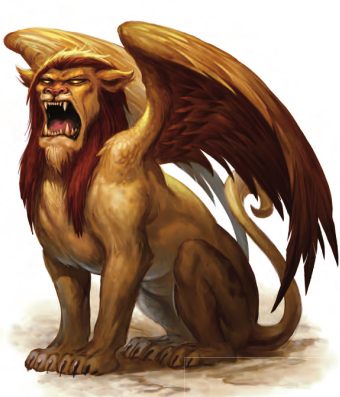Let's Read the 4e Monster Manual/Vault: Sphinx

This article is part of a series! Click here to see the other entries.
Sphinxes are inspired by Greek and Egyptian mythology and have been in the game at least since BECMI. Here, they are only on the Monster Manual.
The Lore
A sphinx is a holy guardian created in antiquity to protect a sacred place like a tomb, temple, or shrine. In this task they can be found alone or in pairs, and sometimes they also command other, lesser guardians. The ritual that creates them is rare and powerful, binding an angelic spirit to the body of a celestial lion.
Why would someone create a sphinx instead of a golem? There’s the matter of style, of course. Golems would be preferred by a certain type of arcane caster, while sphinxes feel like something a deity would allow its greatest servants to make. There are also practical advantages: sphinxes are both sapient and quite smart, so they can follow the intended spirit of their orders, and better distinguish between people who are allowed to be there and people they should eat.
One way they do this is through the sphinx’s challenge, where they try to ascertain if someone has a right to be at the guarded location or not. Riddles are a classic, but a sphinx can also ask for proof of ancestry, the solution to an ethical or theological puzzle, or even just a specific password. The sphinx is bound to let someone who passes the test proceed unmolested, though it’s still going to attack if the visitors try to damage or rob the guarded location.
That’s all the book has to say about sphinxes, but I think we can speculate a bit as well. Unlike most of other “guardian creatures” we saw so far, sphinxes are neither constructs nor undead, yet the text implies they’re just as capable of guarding their designed site for eternity. So I think it’s fair to say that they are immune to age, hunger, thirst and possibly even sleep, at least when performing their mission.
While the books emphasize the role of sphinxes as the guardians of “ancient” and “forgotten” places, I think it’s also quite possible for them guard places that are neither. Maybe the Pelorite cathedral or the big Temple-Library of Ioun have a pair of sphinxes posted at their front entrance, even though they’re built right in the middle of major population centers. Sphinxes are perfect for this because they’re intelligent, and so they’re not going to attack innocent visitors by mistake like a golem would.
A good sphinx might be hamstrung by overly specific or ethically questionable bindings, though, so you could also have a scenario where a party carefully helps the creature to free itself from its duties without triggering a fight.
The Numbers
There’s only one stat block, so we’ll get right on it. Sphinxes are Large Immortal Magical Beasts, and Level 16 Elite Soldiers with 304 HP. They have trained Perception, Darkvision, plus a ground speed of 6, a flight speed of 8 (clumsy) and Overland Flight 10.
Their signature trait is the Sphinx’s Challenge, which gives us mechanics for the concept described in the lore section: the sphinx will pose an out of combat challenge to any potential intruders, and it can take whatever form the GM thinks is appropriate. If the challenged party refuses to answer, or gets the answer wrong, the sphinx will gain 1 extra action point and a +2 to attack, damage, and defenses in the ensuing combat. Note that attacking the sphinx before it can make its challenge counts as a refusal to answer! I think the only case where the party can fight a sphinx without these bonuses is if they pass the challenge and are later caught robbing the guarded place.
In combat, this sphinx is a straightforward physical threat. It attacks with claws, it can pounce to make a charge and knock the target prone on a hit, and it has a frightful roar (close burst 10 vs. will) which gives victims a -2 penalty to defense (save ends). It can also use a Second Wind once per encounter, which works like the PC version: the sphinx heals 75 HP and gains +2 to all defenses for a turn.
It’s of course possible for the sphinx to know all sorts of rituals, and for the GM to create custom sphinxes with the common traits above and a more magical selection of combat abilities.
Sample Encounters and Final Impressions
The sample encounter is level 15: 1 sphinx, 1 battle guardian, and 2 helmed horrors. Indeed, a sphinx is smart enough that it could be given command of those guardian constructs and employ them in interesting ways.
I like the concept of sphinxes, and I kinda want to run an adventure where the sphinxes at the Temple-Library of Ioun are upstanding members of their community and know everyone in the city by name.